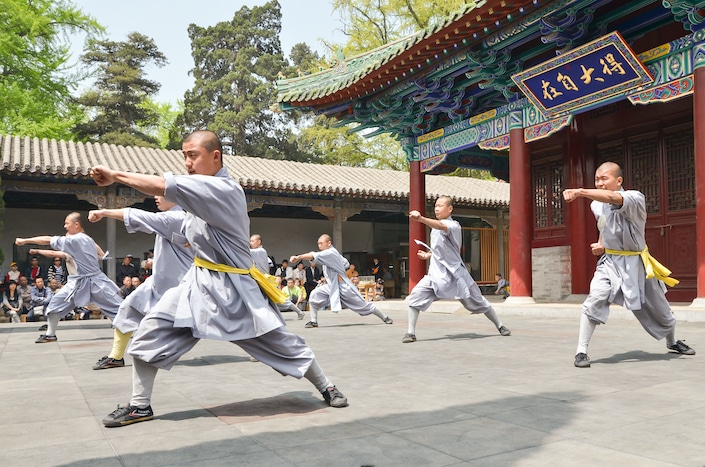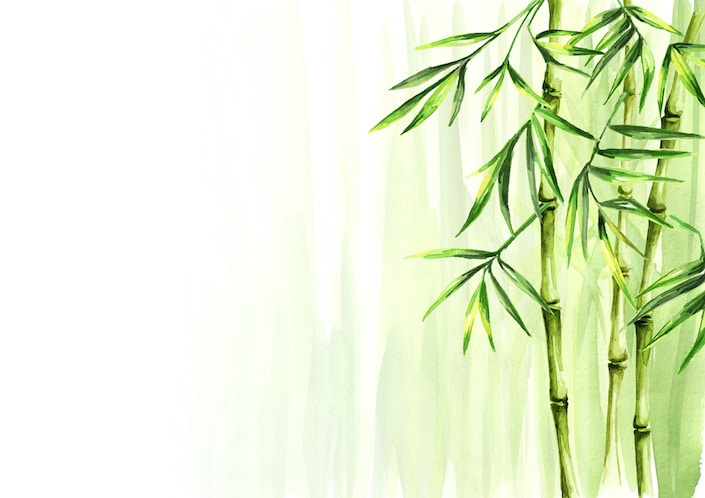Religion in Ancient China: A Melting Pot of Beliefs
Learn Chinese in China or on Zoom and gain fluency in Chinese!
Join CLI and learn Chinese with your personal team of Mandarin teachers online or in person at the CLI Center in Guilin, China.
Most people have a basic understanding of the role that religions and belief systems like Buddhism, Taoism and Confucianism played in ancient China. What’s less well-known is the fact that, as a major trading power for much of its history, China has also been influenced by a plethora of other religions, from Judaism to Islam. Read on to explore the stunningly diverse field of religion in ancient China.

Confucianism
Confucianism (儒家思想 or Rújiāsīxiǎng) is the system of thought that has had the most profound influence on Chinese culture and society. It emphasizes family relationships, education and the importance of rituals.
Confucianism was founded by Confucius (孔子 or Kǒngzǐ), a civil servant and teacher from Shandong Province who lived from 551 to 479 BCE. The classic Confucian texts, known as the Four Books and Five Classics, formed the cornerstone of the Chinese educational system for hundreds of years.
Students were required to demonstrate mastery of Confucian doctrines when taking part in the imperial examinations (科举考试 or kējǔ kǎoshì), which were used to select Chinese government officials in ancient China.
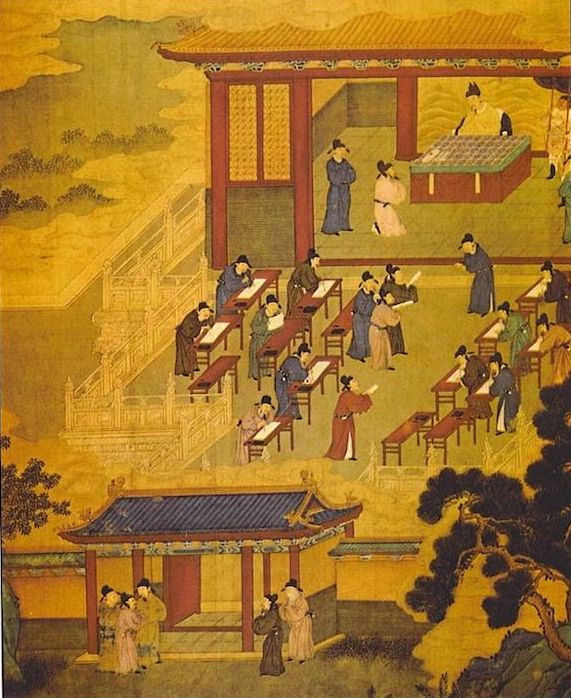
Government officials in ancient China were required to demonstrate mastery of Confucian doctrines.
The importance of filial piety
Many of Confucius’ teachings focus on how to best organize a harmonious society based on the family as its fundamental unit. According to Confucian thought, relationships within the family should be based on filial piety (孝 or xiào), which means that younger family members must respect, honor and obey their parents, older relatives and ancestors.
The relationship between parents and children was just one of the 5 cardinal relationships (五伦 or wǔlún) that made up the traditional Confucian social hierarchy. These relationships included that between father and son, husband and wife, older brother and younger brother, friend and friend, and ruler and ruled.
Confucius believed that if everyone behaved in a filial way and fulfilled their assigned roles within the Confucian hierarchy, the harmony established within the family would then be extended to encompass all of society. Loyalty and devotion to one’s parents would result in loyalty to the state since loyal and filial sons would also become loyal and filial officials.
Even the ancient Chinese legal system was based on the Confucian hierarchy. Punishments were more or less severe depending on the relationship between the offender and the victim.
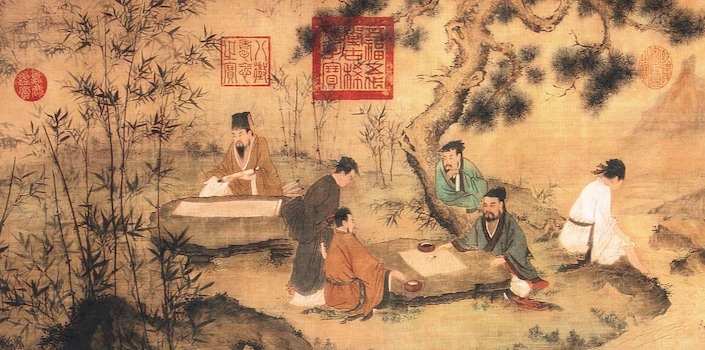
Confucius taught that filial piety was the foundation of a harmonious society.
The Confucian gentleman, or junzi
Confucian ideas about what makes a virtuous life are embodied in his ideas about what constitutes a junzi (君子 or jūnzǐ), or ideal gentleman. Junzi were expected to display the five constant virtues, which included benevolence (仁 or rén), righteousness (义 or yì), ritual propriety (礼 or lǐ), wisdom or knowledge (智 or zhì) and trustworthiness or integrity (信 or xìn).
Confucius strongly emphasized the importance of both study and of putting what one has studied into practice. Becoming a junzi was the ultimate goal of study and self-cultivation, and Confucius was optimistic about the potential of all human beings to better themselves in the process. This Confucian emphasis on education can still be seen in modern China today.
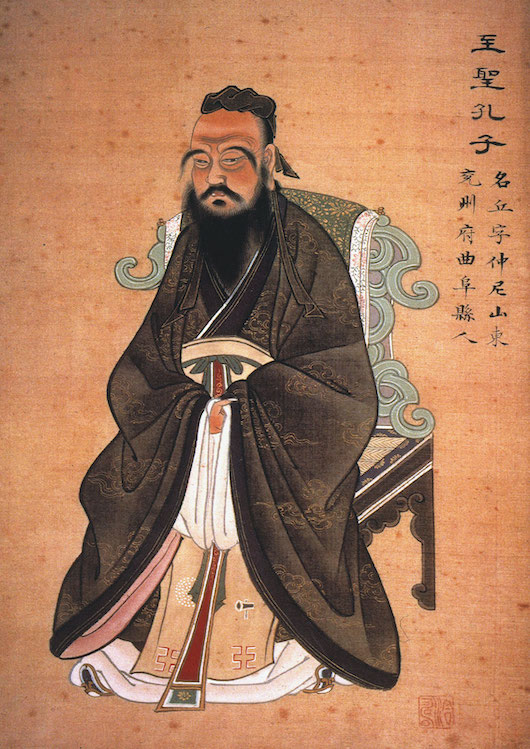
The ideal Confucian gentleman was expected to be benevolent, righteous, trustworthy and wise.
Legalism
Legalism (法家 or Fǎjiā) is another ancient system of thought that has had an outsized impact on Chinese society, most notably when it comes to the formation of a strong bureaucracy. Echoes of Legalist thought can be found in the current emphasis that China’s leaders have placed on creating a society built on the rule of law (法治社会 or fǎzhì shèhuì).
Legalism developed during China’s Warring States period (475-221 BCE) and formed the basis of the government during China’s first dynasty, the Qin (221-207 BCE).
Legalist beliefs
The Legalists believed that people are inherently selfish. Thus, social stability could not be achieved by relying on common people to be virtuous and loyal to their rulers.
Instead, the Legalists advocated for strong state control and absolute obedience of subjects to their rulers. To help achieve this vision, they developed innovative management and administrative techniques in hopes of building an ideal bureaucracy.
To help enforce state control, the Legalists also advocated for a rigid, strict and impersonal system of laws which punished or rewarded certain behaviors in a universal way, regardless of the relationship between offender and victim.
For Legalists, the state’s prosperity and military strength were more important than ordinary people’s welfare. This focus on political maneuvering and manipulation has drawn comparisons between Legalism and Machiavellianism and Realpolitik.
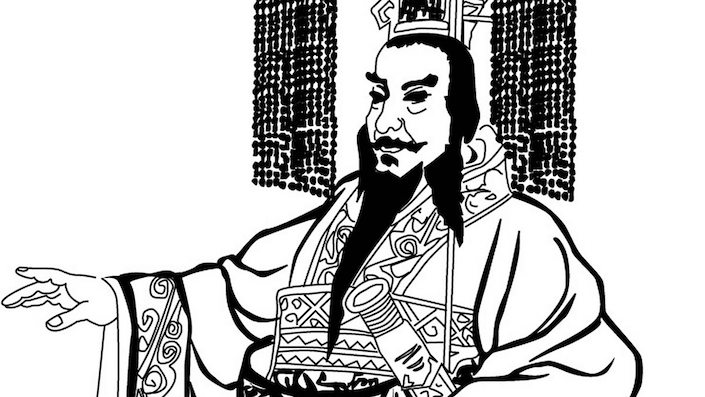
Legalists advocated a strong state in which people were governed by strict, impersonal laws.
Conflict with Confucianism and decline
For a time, Confucianism and Legalism were competing philosophies of government. During the Qin, Confucian scholars were executed and their books were destroyed in an episode known as the burning of books and the burial of scholars.
The Qin dynasty’s heavy handed law enforcement policies made Legalism extremely unpopular. During the Han dynasty (206 BCE–220 CE), Legalism was suppressed and eventually abandoned in favor of Confucianism.
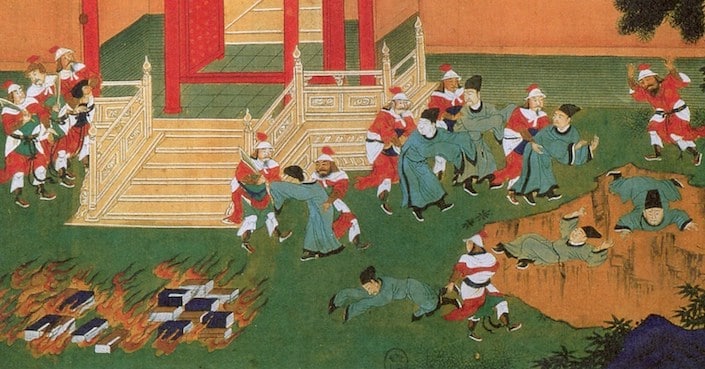
During the Qin dynasty, followers of Legalism destroyed Confucian works and executed Confucian scholars.
Taoism
Taoism (道教 or Dàojiào), also called Daoism, is another important ancient Chinese philosophical and religious tradition that continues to have a significant influence on Chinese society today.
The origins of Taoism
Laozi (老子 or Lǎozi) is often credited as the founder of Taoism and many of the belief system’s basic tenets are laid out in the 4th century BCE Tao Te Ching, a classic text attributed to him.
Many Taoist beliefs and traditions probably predate Laozi, however, and some can trace their roots all the way back to ancient prehistoric folk religions. One example is the concept of yin and yang, which plays an important part in Taoist cosmology. Although it did not originate with Taoism and has been used in various other Chinese religions over the years, the yin yang concept makes an appearance in the Tao Te Ching.
Today, the yin yang symbol, which represents a balance between yin, or dark, receptive, female energy, and yang, or bright, active, male energy, is closely associated with Taoism. In fact, yin yang symbols are often used as part of the decoration of Taoist temples in modern China, making them easy to identify.
In addition to the Tao Te Ching, the other foundational text of Taoism is the Zhuangzi, a book of stories and anecdotes with Taoist themes.
Taoism gained official state recognition in China during the Tang dynasty (618-907 CE) when the ruling family claimed to be descended from Laozi. The Tang emperors officially promoted Taoism and added Taoist texts to the imperial examinations.
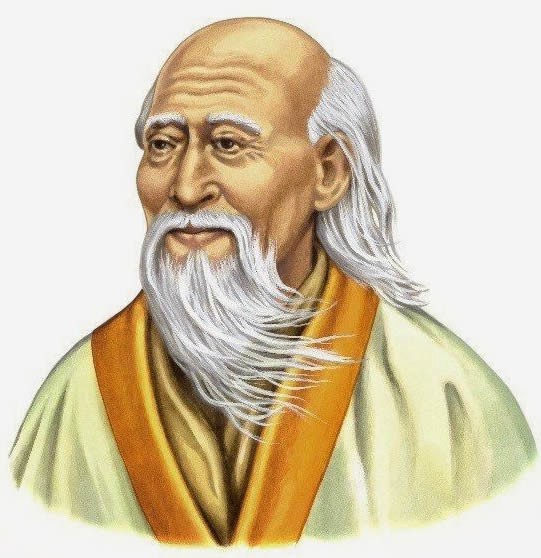
Laozi is believed to have been the founder of Taoism.
Taoist teachings: going with the flow
Taoism emphasizes the importance of harmony in the relationship between humans and the natural world, which is regulated by an indefinable, powerful metaphysical or spiritual force called the dao (道 or dào), sometimes translated as the “way.”
Taoists teach that the best way to live a life of contentment is to be flexible and go along with the dao or natural flow of the universe. Letting go of expectations and accepting things as they are is the key to a blissful existence.
Since trying to exert one’s will on the universe only disrupts its natural state of harmony, Daoists also practice a philosophy of non-action, known as wu wei (无为 or wúwéi) which involves submitting one’s will to that of the universe.
Taoist teachings often describe the “wu wei” philosophy using water-related metaphors. Water may not seem strong, but when it flows freely, it’s able to overcome many obstacles by simply flowing around or through them.
Taoist teachings also emphasize three virtues which are collectively known as the Three Treasures (三宝 or sānbǎo). These virtues are love or compassion (慈 or cí), frugality (俭 or jiǎn) and humility (不敢为天下先 or bù gǎn wéi tiānxià xiān).
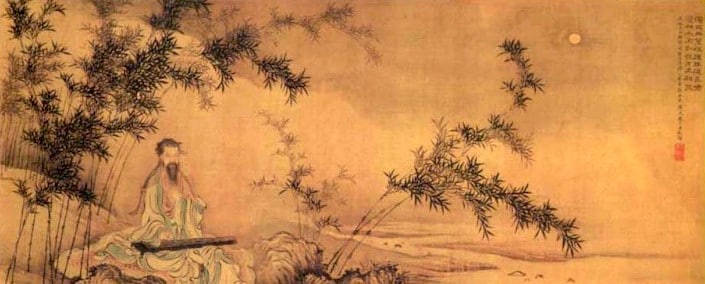
Taoists believe that the universe exists in a natural state of harmony.
Taoism and what can be known
Today, one of the most famous Taoist stories is a fable from the Zhuangzi about a philosopher who dreamed he was a butterfly, as described in the following poem:
昔者莊周夢為胡蝶,栩栩然胡蝶也,自喻適志與。不知周也。
Once, Zhuang Zhou dreamed he was a butterfly, a butterfly flitting and fluttering about, happy with himself and doing as he pleased. He didn't know that he was Zhuang Zhou.
俄然覺,則蘧蘧然周也。不知周之夢為胡蝶與,胡蝶之夢為周與。周與胡蝶,則必有分矣。此之謂物化。
Suddenly he woke up and there he was, solid and unmistakable Zhuang Zhou. But he didn't know if he was Zhuang Zhou who had dreamt he was a butterfly, or a butterfly dreaming that he was Zhuang Zhou. Between Zhuang Zhou and the butterfly there must be some distinction! This is called the Transformation of Things.
— Zhuangzi, chapter 2 (Watson translation)
This story expresses a deep-seated philosophical skepticism about what can be known about the world. This skepticism is a common theme in the Zhuangzi, which also encourages readers to question their understanding of fundamental concepts like right and wrong and good and bad.
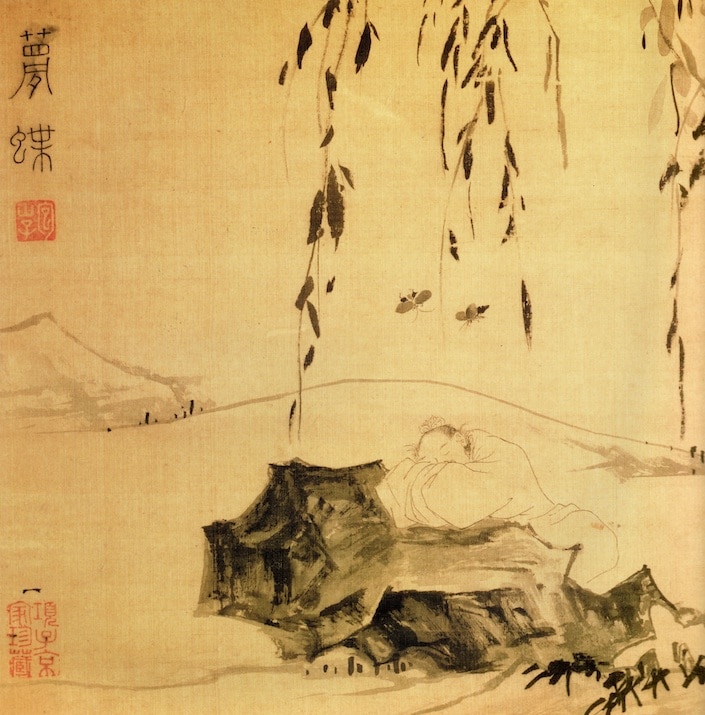
The well-known Taoist story about a philosopher who dreamed he was a butterfly challenges readers to question the nature of reality.
Buddhism
Buddhism (佛教 or Fójiào) is thought to have been founded by Siddharta Gautama in India sometime between the 6th and 4th centuries BCE. After its founding, Buddhism spread throughout Asia. As it did so, multiple different branches developed, including Mahayana, Theravada and Tibetan Buddhism.
Buddhism arrived in China via the Silk Road sometime during the Han dynasty (206 BCE–220 CE). The most commonly practiced form of Buddhism in China today is Chinese Buddhism which includes a mixture of Buddhist and Taoist practices.
Buddhist beliefs
In general, Buddhism teaches that human beings are trapped in a cycle of earthly suffering caused by their transitory desires. Buddhists also believe they are trapped in an ongoing cycle of rebirth which can only be broken through the accumulation of good karma.
By following the teachings of the Buddha, especially those outlined in the Noble Eightfold Path, Buddhists are taught that they can escape from the endless cycle of desire, suffering and rebirth and achieve enlightenment or nirvana. These core Buddhist teachings are encapsulated in The Four Noble Truths (四谛 or sìdì).
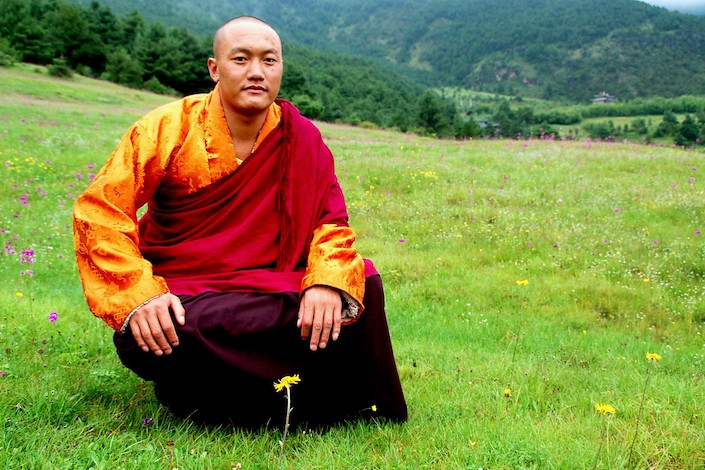
Buddhists try to escape from the earthly cycle of suffering and rebirth by following the Noble Eightfold Path.
The influence of Buddhism on Chinese culture
Buddhism has had a deep influence on Chinese culture, especially the arts, where Buddhist imagery often figures as a central theme. For example, the stunning Mogao Caves are a treasure trove of amazing works of Buddhist art created by generations of artists and pilgrims traveling along the Silk Road.
Buddhism has likewise deeply influenced Chinese literature. Journey to the West, arguably the most famous of China’s Four Great Classical novels, is the fanciful account of the real-life journey of Xuanzang (玄奘 or Xuánzàng), a monk who traveled to India to retrieve Buddhist scriptures during the Tang dynasty (618-907 CE).
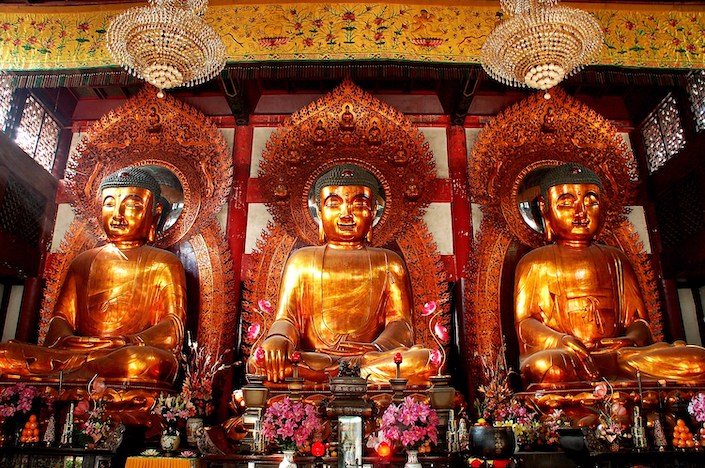
Buddhist beliefs can be seen reflected in many Chinese works of art.
Mythology and Chinese Folk Religions
In addition to more well-known belief systems such as Buddhism, there is also a robust tradition of popular folk religion in China. Today’s residents of the Middle Kingdom are heirs to a rich collection of mythological stories. The stories and beliefs of folk religion and Chinese mythology often overlap.
Chinese folk religion
Chinese folk religion involves the worship of a variety of local gods and immortals (神 or shén). Sometimes, these gods are associated with natural phenomena, sometimes they are historical personages and sometimes they are said to be the early ancestors of their devotees.
In the countryside, worship often takes place in local temples (土地庙 or tǔdìmiào) dedicated to village gods.
As with many of the other religious and philosophical traditions practiced in China, Chinese folk religion is very inclusive. It’s possible and, in some places, even common for people to believe in both the local gods of the Chinese folk religion, the Taoist immortals and the Buddha simultaneously.

Many parts of the Chinese countryside are dotted with local temples built to honor village gods.
Chinese mythology
China has also accumulated a huge variety of mythological stories over the years. Many of these myths are fantastical stories which help to explain the creation of the universe, the origin of the human race or the roots of important skills like medicine making. These stories have been passed down in oral form over many millennia.
Chinese mythology doesn’t represent a neat collection or system of internally consistent stories. In many cases, several different competing stories are used to explain the same phenomenon.
Many of the characters in Chinese mythology are also considered deities in Chinese folk religion. There is also a lot of cross-pollination and sharing of concepts, stories and even deities between Chinese mythology and Buddhism, Taoism and Confucianism.
Some of the more well-known stories from Chinese mythology include:
- The legend of Pangu (盘古 or Pángǔ), creator of the universe
- The legend of Nüwa (女娲 or Nǚwā), said to have created the human race out of clay
- The legend of Shennong (神农 or Shénnóng), creator of agriculture, the Chinese calendar and Chinese medicine
- The legendary ruler Huangdi (黄帝 or Huángdì), also called the Yellow Emperor, thought to be the ancestor of the Chinese people
- The Jade Emperor (玉皇大帝 or Yùhuángdàdì), a mythological figure and Taoist deity considered to be the ruler of heaven in charge of all the other gods
Many traditional Chinese holidays, such as the Qingming, Mid-Autumn and Qixi festivals, also have Chinese mythological stories associated with them.
In addition to the mythical figures mentioned above, Chinese mythology is full of stories about animals, both real and imaginary. As one of the most important creatures in Chinese mythology, Chinese dragons play a decisive role in these stories.
Chinese mythology also exists within the Chinese zodiac in the form of the various myths and legends that explain the order and personalities of the 12 zodiac animals.

Qixi Festival, also known as Chinese Valentine’s Day, is associated with a mythological story called The Cowherd and the Weaver Girl.
Minority religions and other schools of thought
In addition to the belief systems described above, China has been influenced by a variety of other schools of thought. Some, such as Mohism (墨家 or Mòjiā), a system of beliefs based on the promotion of universal love, are homegrown. Many came from overseas, however.
Ancient Chinese religious diversity
For those interested in the influence of foreign religions on ancient China, there is no better place to start than Quanzhou, a port city in Fujian Province which was once the starting point of China’s Maritime Silk Road.
During the Middle Ages, which coincided with China’s Yuan dynasty (1271–1368 CE), traders from around the world converged on this city, bringing with them a variety of international religions.
Today, the city’s vibrant multicultural religious heritage is still visible on the tombstones erected in memory of its foreign residents. Inscriptions on these “Stones of Zayton” attest to the presence of multiple different faiths, including Islam, Nestorianism (an early branch of Christianity), Hinduism and Manicheanism.
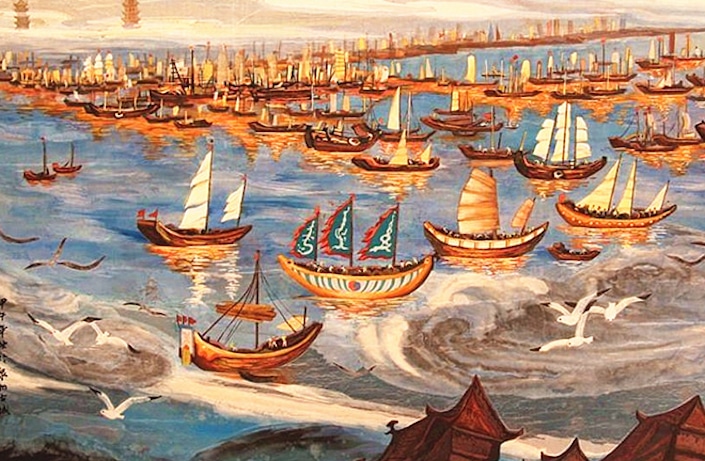
During the Yuan dynasty, traders from all over the world traveled to China, bringing their religions with them.
Jewish Communities in China
China has also been home to a small Jewish community in Kaifeng, Henan Province, since either the Tang (618-907 CE) or the Northern Song dynasty (960–1127 CE).
Most members of this ancient community, known as the Kaifeng Jews, have been assimilated into the broader Chinese community in recent centuries, but there is still a small yet distinct Jewish community living in Kaifeng today.
China also played host to a sizable community of European Jews (犹太人 or Yóutàirén) who arrived in Shanghai after fleeing the Nazis in the 1930’s and 40’s. At its peak, Shanghai’s Jewish community numbered some 20,000 people, but they quickly dispersed after the end of World War II.
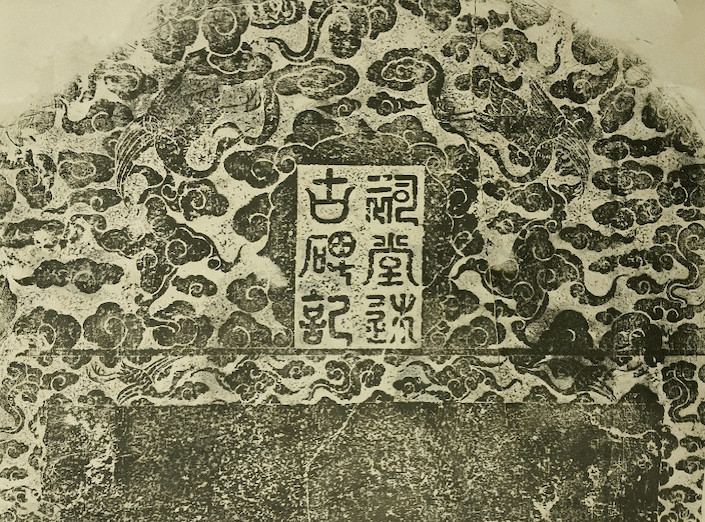
This rubbing, taken from an ancient stele from a Kaifeng synagogue, bears witness to the long history of Jewish communities in China.
China’s early Christian missionaries
Christian missionaries (传教士 or chuánjiàoshì), the majority of whom came from European countries, have had an outsized influence on China throughout much of the country’s more recent history.
The early Jesuit missionaries, especially Matteo Ricci, are notable for the lengths to which they went in their attempts to understand Chinese culture and language. To better communicate with the local people, many learned not only classical Chinese but also obscure regional Chinese dialects.
They worked to find ways to synthesize Chinese and Western belief systems, creating bridges between the academic and scientific knowledge of both cultures.
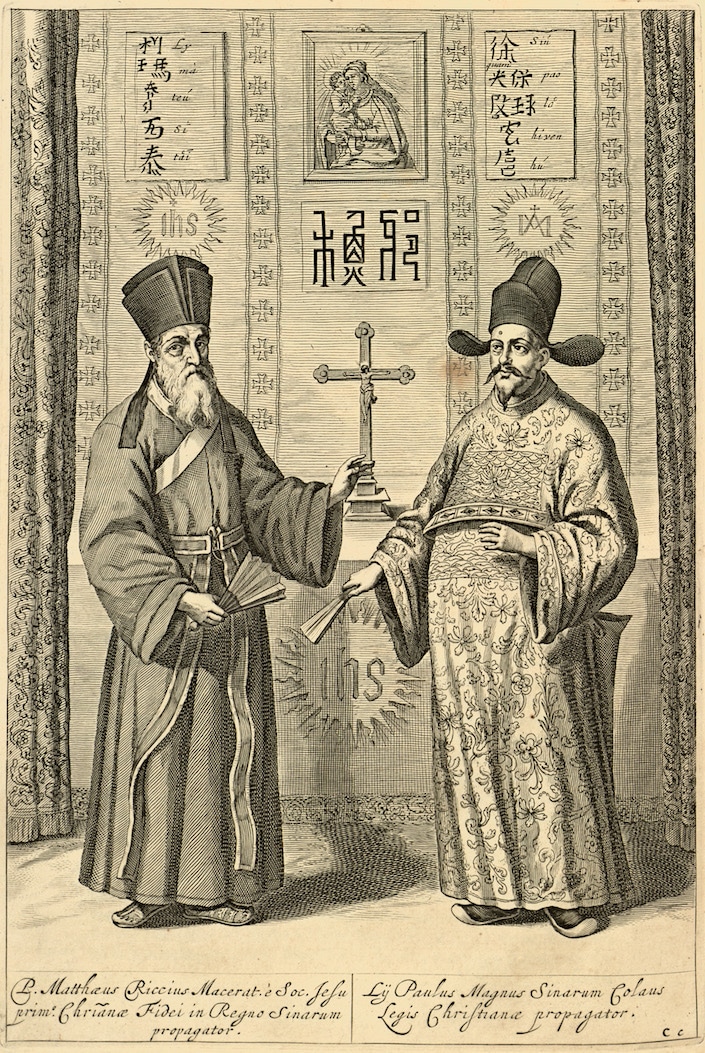
Early Christian missionaries like Matteo Ricci went to great lengths to propagate their faith in China.
Despite bouts of local opposition, European and American Christian missionaries were increasingly active in China after the First Opium War (1839-1842 CE). This was especially the case in the treaty ports, where missionaries kept busy building churches, schools and hospitals while attempting to convert the wider populus.
Although their ideas were frequently rejected by both ordinary people and government officials in most parts of China, a distorted version of Christianity was used as the foundation of the belief system that motivated the instigators of the bloody Taiping Rebellion. Hong Xiuquan, the leader of the Taiping Rebellion, even claimed to be the younger brother of Jesus.
Small Christian communities still exist in China today. Christianity (基督教 or Jīdūjiào) is especially popular in Hong Kong and, to a lesser extent, Macau.

Macau was once an important base for Catholic missionaries planning to work in China, Japan or Southeast Asia.
Islam in China
China and Islam have a long history. In fact, Islam (伊斯兰教 or Yīsīlánjiào) has existed in the country since before the death of the Prophet Muhammed in 632 CE.
Although the date of its founding is disputed, the Huaisheng Mosque (怀圣寺 or Huáishèngsì) in Guangzhou is traditionally said to have been built in 627 CE, only 17 years after the Prophet Muhammed is believed to have began receiving revelations from God.
In the early years after its founding, Islam was brought to China by Muslim traders arriving by sea and land via the Silk Road. These Muslim traders were especially influential in China during the Yuan dynasty (1271–1368 CE), when they, along with other foreign traders, were accorded a higher status than the Han Chinese by the Mongol emporers.
Today, several of China’s ethnic minority groups are affiliated with Sunni Islam. Among them, the most well-known are the Uyghurs and the Hui. Although Chinese Muslims can be found in every major city in China, most of them live in Xinjiang, Gansu, Ningxia and Qinghai.

The history of Islam in China stretches all the way back to before the death of the Prophet Muhammed.
Ethnic minority religions
Although most members of China’s ethnic minority groups are affiliated with one of the more mainstream religions or belief systems mentioned above, members of certain groups still practice their own forms of religion.
For example, members of the Daur, Evenki, Derung, Hezhen and Oroqen ethnic minority groups traditionally practice various forms of Shamanism and Animism.
A religious melting pot
Throughout its long history, China has been profoundly influenced by a variety of religious and philosophical beliefs, some homegrown and some imported.
Understanding this kaleidoscopic array of ancient Chinese religions is essential for anyone who wishes to understand modern Chinese culture and society.
Developing a basic understanding of the diverse set of beliefs that have contributed to shaping Chinese culture is guaranteed to give you a new perspective on everything from Chinese characters to Chinese family relationships to ancient Chinese proverbs and idioms.
Excited to learn even more about Chinese culture and the Chinese language? Come learn Chinese with CLI, either in Guilin or online!
Ancient Chinese religion vocabulary
| Hànzì | Pīnyīn | Definition |
|---|---|---|
| 宗教 | zōngjiào | religion |
| 信仰 | xìnyǎng | faith; belief |
| 哲学 | zhéxué | philosophy |
| 儒家思想 | Rújiāsīxiǎng | Confucianism |
| 孔子 | Kǒngzǐ | Confucius |
| 孝 | xiào | filial piety |
| 法家 | Fǎjiā | Legalism |
| 道教 | Dàojiào | Taoism |
| 老子 | Lǎozi | Laozi |
| 佛教 | Fójiào | Buddhism |
| 犹太人 | Yóutàirén | Jewish people |
| 传教士 | chuánjiàoshì | missionaries |
| 基督教 | Jīdūjiào | Christianity |
| 伊斯兰教 | Yīsīlánjiào | Islam |








